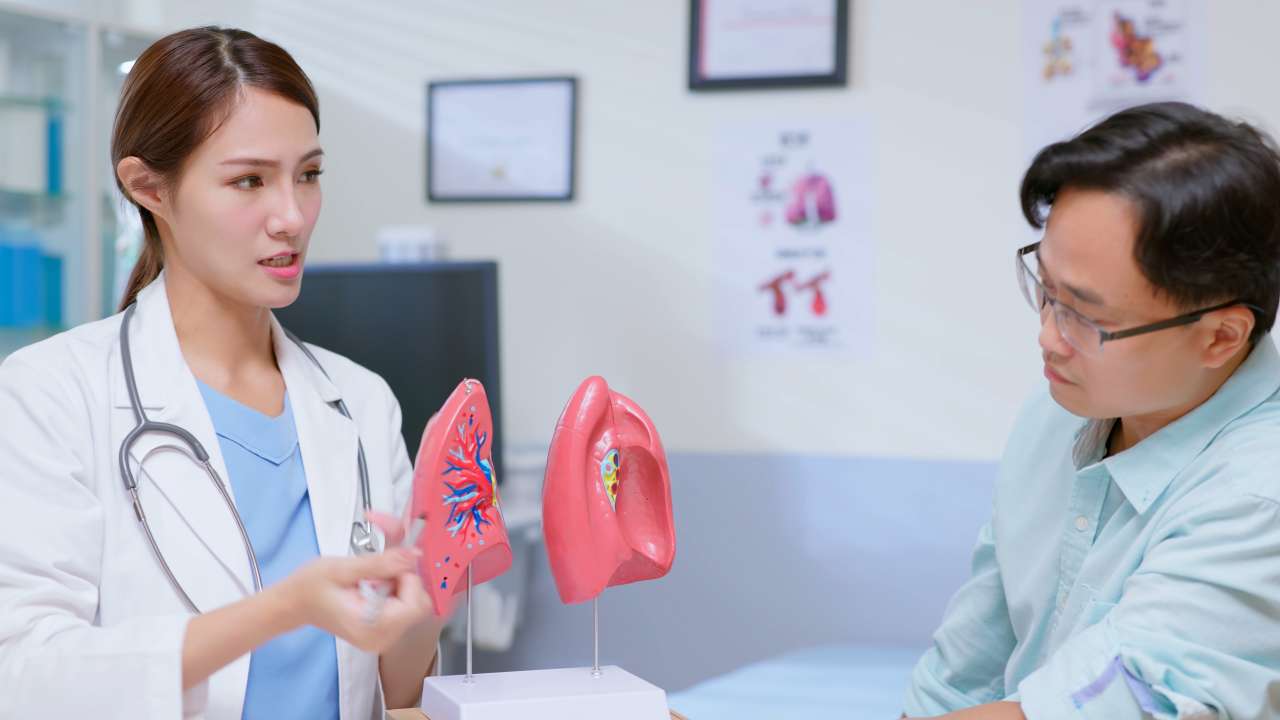Surviving lung cancer can be a relief. But life after lung cancer doesn’t come without worries. Many cancer survivors wonder if the cancer could come back (recur or relapse). But they should also be aware that they are at a high risk of developing a new, unrelated lung cancer, referred to as second primary lung cancer (SPLC) or multiple primary lung cancer (MPLC).
“When a new lung cancer develops, many people assume it’s a relapse,” says Drew Moghanaki, MD, an endowed professor and chief of UCLA Health’s Thoracic Oncology Service in the Department of Radiation Oncology. “But it often isn’t relapse — it’s a new primary lung cancer that is also potentially curable.”
People who develop cancer once often develop more cancers in their lifetime. About one in six cancer diagnoses are second cancers — unrelated to the person’s previous malignancy. Some cancers are more likely to be associated with second cancers. Lung cancer is one of them.
How common is second primary lung cancer?
Lung cancer survivors often live the rest of their lives without relapse. However, survivors of non-small cell lung cancer (NSCLC) or small cell lung cancer (SCLC) are at risk for developing a second cancer. Less commonly, lung cancer survivors can also develop laryngeal (voice box) and thyroid cancers.
Experts estimate the overall risk of a second primary lung cancer for lung cancer survivors is 15% — and the risk increases with age. For instance, people who underwent removal of NSCLC have a 5% risk within the first three years post-cancer. That risk rises to 16% after eight years.
Understanding the risk of second lung cancer
There’s no way to predict whether you’ll develop a second lung cancer. But experts believe your likelihood of developing a second lung cancer may depend on certain risk factors, including:
- Smoking and other lifestyle habits: Making poor lifestyle choices as a cancer survivor may affect your risk of a second cancer. Smoking after a prior cancer greatly increases your risk for second primary lung cancer.
- Age: Young lung cancer survivors have a higher risk of developing a second lung cancer, especially since the risk rises every year of survivorship.
- Cancer treatments: Some types of treatment, such as chemotherapy and radiation therapy, can increase your risk of a second cancer.
- Family genetics: Inherited cancer-related genes raise your risk of developing multiple cancers.
“We have patients who have developed as many as nine multiple primary lung cancers,” Dr. Moghanaki says. “But when we catch them early, each of these lung cancers can be cured, sometimes without any chemotherapy.”
If you are a lung cancer survivor, talk to your physician about ways to reduce your risk for second primary lung cancer. Seeing your physician regularly after completing lung cancer treatment can increase the chances of detecting a second cancer early.
Diagnosing and treating multiple primary lung cancer
Experts recommend that lung cancer survivors continue to screen for lung cancer. That increased screening helps identify new primary lung cancers, but an accurate diagnosis is always critical. A new lung nodule in a lung cancer survivor is treated differently if it’s metastatic cancer and not a new and potentially curable second primary lung cancer. Metastatic cancers start elsewhere in the body and spread to the lung.
“Second lung cancers are often diagnosed as adenocarcinoma (the most common type of NSCLC). We treat those second lung cancers with local therapies, both surgical and nonsurgical,” Dr. Moghanaki says. “These patients often don’t undergo chemotherapy or the side effects that go with it.”
He stresses that getting an accurate second primary lung cancer diagnosis and choosing an effective treatment plan often require a multidisciplinary approach. Treatment options for new primary lung cancers can include:
- Surgery, the most common response to lung adenocarcinomas
- Stereotactic ablative radiation, which focuses radiation directly on the tumor
- Percutaneous ablation, which destroys a tumor with cold or heat
- Immunotherapy, which uses medicine to trigger your immune system
- Targeted therapies, drugs that target the genetic changes that help cancer cells grow
- Chemotherapy, which uses medicine to kill tumors
Still more to learn about multiple primary lung cancer
There are a lot of unanswered questions about second primary lung cancer. But researchers are working to gain a better understanding of:
- Causes of second primary lung cancer: Experts believe the likelihood of a second lung cancer may be associated with certain factors, such as tobacco use, family history, genetic factors, and exposure to environmental toxins and pollution.
- Monitoring for second primary lung cancer: There aren’t any established guidelines for detecting second primary lung cancers. But doctors monitor survivors for recurring cancer more than second cancers. And lung cancer screening guidelines aren’t clearly outlined for people who have already had lung cancer.
- Second primary lung cancer detection and treatment: Researchers continue to study the most effective ways to determine where the cancer originated and how to treat it best.
“Researchers are studying why people develop lung cancers either once, twice or multiple times,” Dr. Moghanaki says. “As we know that lung cancer survivors can develop new second primary lung cancers, we are always keeping an eye to make sure we can offer as many chances for cure as needed. This way, people can live out their best lives without dying from lung cancer.”




